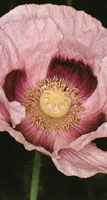View crop
View crop Data sheet EcoPortPapaver somniferum
 |
|
| Notes |
|---|
| BRIEF DESCRIPTION A herb reaching 50-150 cm in height, while the root system may reach 50-100 cm below the soil surface. It has rosette leaves and more scattered leaves on the stems and a single dark or violet-shaded to white flower on each stem, developing into a capsular with seeds. USES The latex from the unripe capsular, called opium, has medicinal properties and narcotic effects. The nonnarcitic seed can be used in bakery or extracted for an oil used in paints, varnishes and soap. The plant has attractive flowers and are used as an ornamental in flower gardens. KILLING T The sprouts can survive -5°C. GROWING PERIOD Annual, grown as a winter crop in the subtropics it require 135-170 days to mature and as a summer crop in temperate areas it require 150-210 days. Under optimal conditions the growing stages may be as follow: germination period 15-20 days, rosette stage 50-60 days, elongation and branching period 25-30 days, blossoming and seed formation stage 20-30 days, and ripening period 15-25 days. COMMON NAMES Opium poppy. FURTHER INF Opium poppy is native to the Mediterranean region or western Asia. It is sensitive to strong winds and sensitive to rain at harvest. Dry warm weather is most appropriate at the time of flowering and capsule ripening. The crop extracts about 102.5 kg of N, 192 kg of P and 11.4 kg of K from the soil to produce 3.5 t/ha of vegetative mass and 1.2 t/ha of fruit. Poppy should not be grown on the same field more than 3-5 years running. Opium obtained from the immature capsules have analgesic and narcotic effects. Seed yields of 2.2-3.0 t/ha are possible, although 1.2-1.8 t/ha are more usual, the optimum yield of dry capsule is 2.0 t/ha. | Sources |
| SOURCES (P. somniferum L.) Kernick M 1961 pp 364 Roecklein 1987 pp 289 [USE, RAIN, FER, DRA] Duke J 1975 pp 23 [PH, RAIN, TEMP] Hornok L 1992 pp 119-128 [TEMP, KTMP, RAIN, TEXT, FER, PH, USE] |